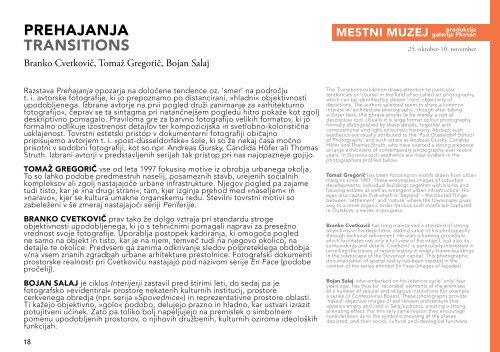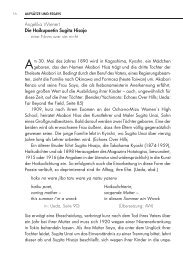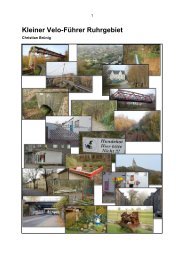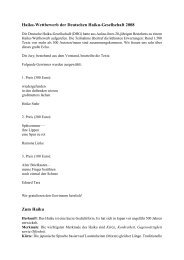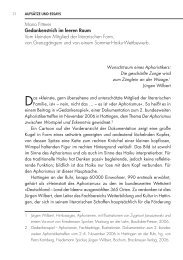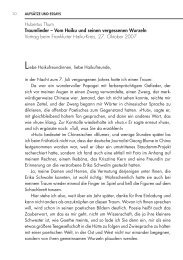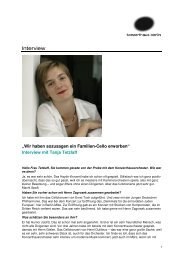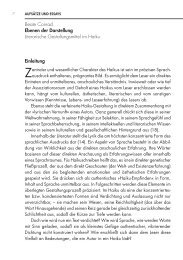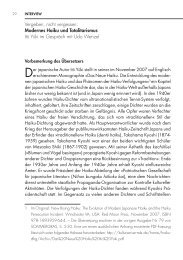Untitled - Kulturserver
Untitled - Kulturserver
Untitled - Kulturserver
You also want an ePaper? Increase the reach of your titles
YUMPU automatically turns print PDFs into web optimized ePapers that Google loves.
PREHAJANJA<br />
TRANSITIONS<br />
Branko Cvetkovič, Tomaž Gregorič, Bojan Salaj<br />
MESTNI MUZEJ<br />
produkcija<br />
galerija Photon<br />
25. oktober-10. november<br />
Razstava Prehajanja opozarja na določene tendence oz. ‘smer’ na področju<br />
t. i. avtorske fotografije, ki jo prepoznamo po distancirani, »hladni« objektivnosti<br />
upodobljenega. Izbrane avtorje na prvi pogled druži zanimanje za »arhitekturno<br />
fotografijo«, čeprav se ta sintagma pri natančnejšem pogledu hitro pokaže kot zgolj<br />
deskriptivno pomagalo. Praviloma gre za barvno fotografijo velikih formatov, ki jo<br />
formalno odlikuje izostrenost detajlov ter kompozicijska in svetlobno-koloristična<br />
usklajenost. Tovrstni estetski pristop v dokumentarni fotografiji običajno<br />
pripisujemo avtorjem t. i. »post-düsseldorfske« šole, ki so že nekaj časa močno<br />
prisotni v sodobni fotografiji, kot so npr. Andreas Gursky, Candida Höfer ali Thomas<br />
Struth. Izbrani avtorji v predstavljenih serijah tak pristop pri nas najopazneje gojijo.<br />
TOMAŽ GREGORIČ vse od leta 1997 fokusira motive iz obrobja urbanega okolja.<br />
To so lahko podobe predmestnih naselij, posameznih stavb, urejenih socialnih<br />
kompleksov ali zgolj nastajajoče urbane infrastrukture. Njegov pogled pa zajame<br />
tudi tisto, kar je »na drugi strani«; tam, kjer izginja prehod med »naseljem« in<br />
»naravo«, kjer se kultura umakne organskemu redu. Številni tovrstni motivi so<br />
zabeleženi v še zmeraj nastajajoči seriji Periferije.<br />
BRANKO CVETKOVIČ prav tako že dolgo vztraja pri standardu stroge<br />
objektivnosti upodobljenega, ki jo s tehničnimi pomagali napravi za presežno<br />
vrednost svoje fotografije. Uporablja postopek kadriranja, ki omogoča pogled<br />
ne samo na objekt in tisto, kar je na njem, temveč tudi na njegovo okolico, na<br />
detajle te okolice. Predvsem ga zanima odkrivanje sledov polpreteklega obdobja<br />
v/na vsem znanih zgradbah urbane arhitekture prestolnice. Fotografski dokumenti<br />
prostorske realnosti pri Cvetkoviču nastajajo pod nazivom serije En Face (podobe<br />
pročelij).<br />
BOJAN SALAJ je ciklus Interijerji zastavil pred štirimi leti, do sedaj pa je<br />
fotografsko »evidentiral« prostore nekaterih kulturnih institucij, prostore<br />
cerkvenega obredja (npr. serija »Spovednice«) in reprezentativne prostore oblasti.<br />
Ti kažejo objektivno, »golo« podobo, delujejo prazno in hladno, kar ustvari izrazit<br />
potujitveni učinek. Zato pa toliko bolj napeljujejo na premislek o simbolnem<br />
pomenu upodobljenih prostorov, o njihovih družbenih, kulturnih oziroma ideoloških<br />
funkcijah.<br />
The Transitions exhibition draws attention to particular<br />
tendencies or ‘course’ in the field of so-called art photography,<br />
which can be identified by distant ‘cold’ objectivity of<br />
depictions. The authors selected seem to share a common<br />
interest in ‘architecture photography’, though after taking<br />
a closer look, this phrase proves to be merely a sort of<br />
descriptive tool. Usually it is large format colour photography,<br />
formally distinguished by sharp details, together with<br />
compositional and light-colouristic harmony. Abroad, such<br />
aesthetics are usually attributed to the ‘Post Düsseldorf School<br />
of Photography’ and such artists as Andreas Gursky, Candida<br />
Höfer and Thomas Struth, who have exerted a strong presence<br />
at large exhibitions of contemporary photography over recent<br />
years. In Slovenia such aesthetics are most evident in the<br />
photographers profiled below.<br />
Tomaž Gregorič has been focusing on motifs drawn from urban<br />
margins since 1997. These encompass images of suburban<br />
developments, individual buildings together with blocks and<br />
housing estates as well as emergent urban infrastructure. His<br />
eyes also capture that which is ‘beyond’ – the blurred fringe<br />
between ‘settlement’ and ‘nature’ where the townscape gives<br />
way to a more organic order. Various such motifs are captured<br />
in Outskirts, a series-in-progress.<br />
Branko Cvetkovič has long maintained a standard of strong<br />
objectivity in his depictions, adding value to his photography<br />
through technical refinement. He uses a framing procedure<br />
which facilitates not only a full view of the object, but also its<br />
surroundings and details. Cvetkovič is particularly interested in<br />
unveiling the traces of recent history in widely known buildings<br />
in the townscape of the Slovenian capital. This photographic<br />
documentation of spatial reality has been created in the<br />
context of the series entitled En Face (images of façades).<br />
Bojan Salaj, who embarked on his Interiors cycle ‘only’ four<br />
years ago, has thus far ‘recorded’ elements of the premises<br />
of a number of secular and religious institutions (for example<br />
a series of Confessional Boxes). These photographs provide<br />
‘naked’ objective images of well-known architecture that<br />
appears empty and cold in Selaj’s photos, creating a strong<br />
alienating effect. For this very same reason they encourage<br />
consideration as to the symbolic meaning of the places<br />
depicted, and their social, cultural and ideological functions.<br />
18


